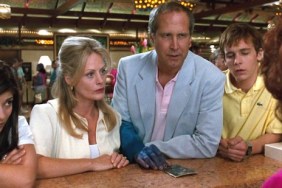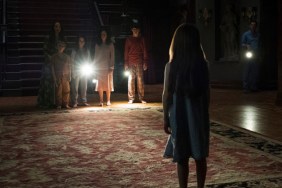
If you’ve seen the movie Sin City, or any of the trailers for this weekend’s release of the sequel, Sin City: A Dame to Kill For, you may need to swab out your ears. Because these movies, based on the comic book series by Frank Miller and co-directed by Robert Rodriguez (El Mariachi) and Miller himself, are shouting at the top of their lungs that they are film noir. “LOOK AT US,” they seem to cry. “ARE WE NOT BLACK & WHITE AND PACKED WITH MORAL CORRUPTION?!”
Check Out: The Best Movie Ever: All-Star Casts
Well, yes, but just because the Sin City movies use film noir as their stylistic compass, and evoke every last trope known to fans of the genre, that doesn’t mean that either of them is actually the best film noir ever. Which begs the question: what really is The Best Film Noir Ever? Well, don’t you worry, cine-fans. That’s what we’re here to find out in this week’s pulse-pounding installment of The Best Movie Ever!
We asked our CraveOnline film critics William Bibbiani, Witney Seibold, Fred Topel and Brian Formo to privately investigate their massive knowledge of film noirs and then publicly declare which single film is the best noir ever made, based entirely on their own, personal criteria. You can read why they made their own selections below, and vote for your own favorite noirs at the bottom of the page.
Let’s get cracking!
Witney Seibold:

Oh man. I love film noir. Who doesn’t? But what to choose?
I was this close to selecting Roman Polanski’s neo-noir classic Chinatown as the best noir film ever. It is, after all, a great film. But Chinatown, we must remember, was a throwback movie. When it came out in 1972, film noir was pretty much out of vogue. What Polanski did was resurrect the form in the filmmaking idiom of the 1970s, a stirring and awesome decade for American film. I figured, though, I’d rather reach back to the original wave of film noir, which hit both Hollywood and France hard in the 1940s and 1950s. Once I had settled a time-frame, however, I still had to decide whether to choose a classic American noir – which tend to be lurid and titillating – or a classic French noir – which tend to be stylish and sexy. I’m a huge fan of Jean-Pierre Melville, of Quai De Orfèvres, of Rififi, of Le Corbeau. For a split second, I considered Who Framed Roger Rabbit? as the best noir film ever, but then I would just be being cute.
But ultimately, I had to settle on the noir film that, in my eye, was the pinnacle of the genre during its golden age. So I select Billy Wilder’s 1944 film Double Indemnity. In it, two decidedly square-looking actors, Fred MacMurray and Barbara Stanwyck, play an insurance salesman and a vamp respectively, who plot to off her husband for the insurance money. There is, however a double indemnity clause in his policy that states that Stanwyck will get double the payout of he dies on a train. The machinations required to arrange an “accidental” death on a train are harrowing, hilarious, tense, dark, and awesome. And the classic elements are all in play: There are no heroes, greed and lust overwhelms ordinary-to-horrible people, and no one can get away with anything. Double Indemnity may not have the seediness of The Big Sleep, but it’s slick and awesome and always exciting to watch.
Brian Formo:

When the film noir took off in the 1940s it seemed to be able to get away with more scandalous words, more seductive sleepwear and more hard drinking because usually those who’d done wrong were punished at the end. Fritz Lang pushed the noir envelope as far as he possibly could against the Hollywood Production Code in The Woman in the Window. And when they rejected his ending for being immoral, he tacked on a 30-second over-the-top, gee-golly-I’m-glad-to-be-alive second ending (that would later be done with earnestness in Frank Capra’s It’s a Wonderful Life). Despite ending in a tonally odd manor when viewed today, if Lang’s final decision was a cinematic “fuck you” to (what’s now) the MPAA then his film is the best film noir ever. Lang ratcheted up the tension, gave a dark ending and then tap-danced expletives at the censor board.
What’s also interesting about The Woman in the Window is that, instead of giving us another weary detective, Lang drops his hero/anti-hero (Edward G. Robinson) into academia. Robinson plays a professor who opens the film by teaching the psychological acceptance of when murder is agreed to be just (in defense) and when it is viewed as immoral (for personal gain; again distinctions from the Production Code). Once he’s seduced by said “woman in the window” (Joan Bennett) he’ll soon find his theories put to the test.
Film noir itself was an important genre for legitimizing cinema as an artform — the use of shadows for terror, the seductive placement of limbs replacing seductive dialogue, etc. As such, film criticism also shifted in the 40s and 50s to include more artful analysis of movies (suggestion: read early 1940s film criticism from novelist James Agee when he started at Time magazine in 1942, the critic was hugely influential to our big American critics of the 60s onward — Pauline Kael and Roger Ebert, etc. Agee himself was excited by noir and pulp films, often fighting to include them in Time, and he later went on to write the seminal, noir-inspired Night of the Hunter script). With Woman in the Window (which was in the middle of four consecutive film noirs from the auteur), Lang took an academic approach to murder by including a main character who, despite being an everyday academic, can also easily be seduced by those same pulpy, “lower class” shenanigans. And then Lang flips off the censors.
Woman in the Window was very far ahead of its time and now it’s been overlooked in the canons of the great original noirs, most likely because of its final minute. But the first 105 minutes still hold up as one of the most suspenseful, artful noirs ever made. Up until the final minute. Afterward, you should laugh. We’re sure that Lang did.
William Bibbiani:

What makes the perfect film noir? The problem with the genre – if, indeed, there is one – is that it’s ever so vaguely defined. Some people think a film counts as noir if it’s about a detective and has striking shadows, but beneath that seemly overbellow is an unseemly core of moral corruption and… sleaze.
Yes, when I think of film noir I think of sleaze. That base amorality that extends to every single character and robs the film of moral value, except perhaps as a cautionary tale to the audience. And although the termination of the Hays Code and the formation of the MPAA ratings system freed the noir genre to indulge in crass excess in the decades that followed – and led to any number of so-called “neo-noir” classics like Blue Velvet and The Grifters – no film noir seems to push the envelope of soulless ickiness like Robert Aldrich’s Kiss Me Deadly, an unfaithful but absolutely lurid adaptation of Mickey Spillane’s “Mike Hammer” classic that pits a bullying, sexist, manipulative P.I. (Ralph Meeker) and his professional seductress girl Friday (Maxine Cooper) against a far-reaching criminal conspiracy to locate “The Great Whatsit.”
What a great name: “The Great Whatsit” is almost certainly an even better title than a “MacGuffin” for a plot point that drives the story forward, but unlike a MacGuffin, The Great Whatsit of Kiss Me Deadly means everything. It means context. The final reveal (which may evoke unexpected comparisons to Pulp Fiction for young audience members who’ve seen the Quentin Tarantino film first) brings the seedy, sweaty grime of Kiss Me Deadly‘s investigation into domestic corruption brings the film into a terrible new world, and possibly a whole new genre. But as the Cold War gradually infects a seemingly unrelated story of Los Angeles criminality, it brings Aldrich’s film to a nearly apocalyptic level of moral apathy. The slate will one day be wiped clean, and the whole world probably deserves to burn.
Fred Topel:

Funny, I just picked Bound for my Best Female Action Hero pick last month. That one might have been a bit of a stretch, but I stand by it. Here it makes total sense, so I’m picking it again. All respect to the classics like Double Indemnity and Sunset Blvd., but the Wachowskis’ modern lesbian genre throwback exceeds on every level.
They had an advantage, to be fair. In the heyday of film noir, you couldn’t show anything graphic in a movie. Even the great seductions of the classic femme fatales were tame, filled with clever innuendo though they were. Portraying a same sex couple was out of the question during the Hays code era.
So start with the kick of seeing the genre played out via two women. Jennifer Tilly is the femme fatale type, and she seduces her neighbor, Gina Gershon, into helping her scam her husband, a mob underling. It’s not an insurance scam, but Joey Pants still plays the sap. The fact that he never suspects his moll is even bisexual, let alone gay, gives her all new manipulations more subtlety than the usual noir love triangle. In a genre as played out as the crime caper, Bound has a fresh approach to the scam, the suspense and the close calls as well to keep the pace pounding for two hours. The way the plan is explained while it is already being executed just gives the audience respect to keep up, and cements the Wachowskis as master storytellers their first time out.








